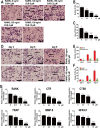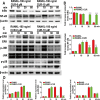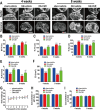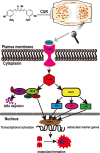Curcumin alleviates osteoarthritis in mice by suppressing osteoclastogenesis in subchondral bone via inhibiting NF-κB/JNK signaling pathway
- PMID: 39236007
- PMCID: PMC11376521
- DOI: 10.1371/journal.pone.0309807
Curcumin alleviates osteoarthritis in mice by suppressing osteoclastogenesis in subchondral bone via inhibiting NF-κB/JNK signaling pathway
Abstract
This study explored the mechanism of curcumin (CUR) suppressing osteoclastogenesis and evaluated its effects on osteoarthritis (OA) mouse. Bone marrow-derived macrophages were isolated as osteoclast precursors. In the presence or absence of CUR, cell proliferation was detected by CCK-8, osteoclastogenesis was detected by tartrate-resistant acid phosphatase (TRAP) staining, F-actin rings formation was detected by immunofluorescence, bone resorption was detected by bone slices, IκBα, nuclear factor kappa-B (NF-κB) and mitogen-activated protein kinase (MAPK) signaling pathways were detected using western blot, osteoclastogenesis-related gens were measured using quantitative polymerase chain reaction. A knee OA mouse model was designed by destabilizing the medial meniscus (DMM). Thirty-six male mice were divided into sham+vehicle, OA+vehicle, and OA+CUR groups. Mice were administered with or without CUR at 25 mg/kg/d from the first post-operative day until sacrifice. After 4 and 8 weeks of OA induction, micro-computed tomography was performed to analyze microstructure changes in subchondral bone, hematoxylin and eosin staining was performed to calculate the thickness of the calcified and hyaline cartilage layers, toluidine blue O staining was performed to assess the degenerated cartilage, TRAP-stained osteoclasts were counted, and NF-κB, phosphorylated Jun N-terminal Kinases (p-JNK), and receptor activator of nuclear factor κB ligand (RANKL) were detected using immunohistochemistry. CUR suppressed osteoclastogenesis and bone resorption without cytotoxicity. CUR restrained RANKL-induced activation of NF-κB, p-JNK and up-regulation of osteoclastogenesis-related genes. CUR delayed cartilage degeneration by suppressing osteoclastogenesis and bone resorption in early OA. The mechanism of CUR inhibiting osteoclastogenesis might be associated with NF-κB/JNK signaling pathway, indicating a novel strategy for OA treatment.
Copyright: © 2024 Ding et al. This is an open access article distributed under the terms of the Creative Commons Attribution License, which permits unrestricted use, distribution, and reproduction in any medium, provided the original author and source are credited.
Conflict of interest statement
The authors have declared that no competing interests exist.
Figures









Similar articles
-
Metformin attenuates osteoclast-mediated abnormal subchondral bone remodeling and alleviates osteoarthritis via AMPK/NF-κB/ERK signaling pathway.PLoS One. 2021 Dec 16;16(12):e0261127. doi: 10.1371/journal.pone.0261127. eCollection 2021. PLoS One. 2021. PMID: 34914744 Free PMC article.
-
Dihydroartemisinin attenuates osteoclast formation and bone resorption via inhibiting the NF‑κB, MAPK and NFATc1 signaling pathways and alleviates osteoarthritis.Int J Mol Med. 2022 Jan;49(1):4. doi: 10.3892/ijmm.2021.5059. Epub 2021 Nov 5. Int J Mol Med. 2022. PMID: 34738623 Free PMC article.
-
Amentoflavone maintaining extracellular matrix homeostasis and inhibiting subchondral bone loss in osteoarthritis by inhibiting ERK, JNK and NF-κB signaling pathways.J Orthop Surg Res. 2024 Oct 15;19(1):662. doi: 10.1186/s13018-024-05075-2. J Orthop Surg Res. 2024. PMID: 39407273 Free PMC article.
-
Zoledronic acid generates a spatiotemporal effect to attenuate osteoarthritis by inhibiting potential Wnt5a-associated abnormal subchondral bone resorption.PLoS One. 2022 Jul 28;17(7):e0271485. doi: 10.1371/journal.pone.0271485. eCollection 2022. PLoS One. 2022. PMID: 35900969 Free PMC article.
-
Neogambogic Acid Suppresses Receptor Activator of Nuclear Factor κB Ligand (RANKL)-Induced Osteoclastogenesis by Inhibiting the JNK and NF-κB Pathways in Mouse Bone Marrow-Derived Monocyte/Macrophages.Med Sci Monit. 2018 Apr 26;24:2569-2577. doi: 10.12659/MSM.909651. Med Sci Monit. 2018. PMID: 29698379 Free PMC article.
Cited by
-
Therapeutic prospects and potential mechanisms of Prdx6: as a novel target in musculoskeletal disorders.Front Physiol. 2025 Apr 17;16:1524100. doi: 10.3389/fphys.2025.1524100. eCollection 2025. Front Physiol. 2025. PMID: 40313876 Free PMC article. Review.
-
Efficacy and mechanisms of curcumin in the treatment of osteoarthritis: A scoping review.Biomol Biomed. 2025 Mar 7;25(4):761-785. doi: 10.17305/bb.2024.11045. Biomol Biomed. 2025. PMID: 39720988 Free PMC article.
-
Mechanism of action and new developments in the study of curcumin in the treatment of osteoarthritis: a narrative review.Inflammopharmacology. 2025 Mar;33(3):929-940. doi: 10.1007/s10787-025-01665-6. Epub 2025 Feb 26. Inflammopharmacology. 2025. PMID: 40009345 Review.
-
A Nutritional Supplement Containing Curcumin C3 Complex, Glucosamine, and Chondroitin Alleviates Osteoarthritis in Mice and Canines.Vet Sci. 2025 May 12;12(5):462. doi: 10.3390/vetsci12050462. Vet Sci. 2025. PMID: 40431555 Free PMC article.
References
-
- G P, MJ T. Osteoarthritis year in review 2020: epidemiology & therapy. OSTEOARTHR CARTILAGE. 2021;29(2):180–9. - PubMed
MeSH terms
Substances
LinkOut - more resources
Full Text Sources
Research Materials
Miscellaneous

